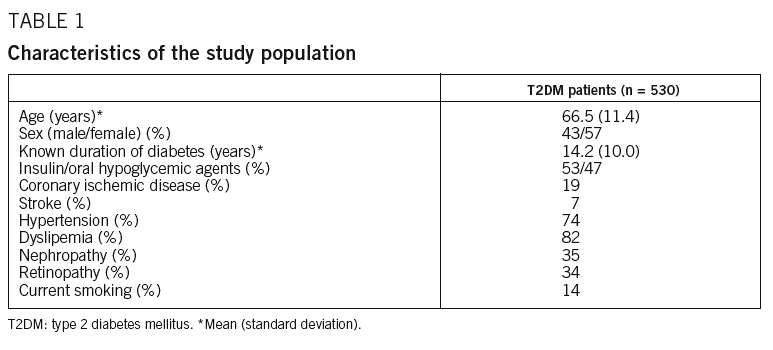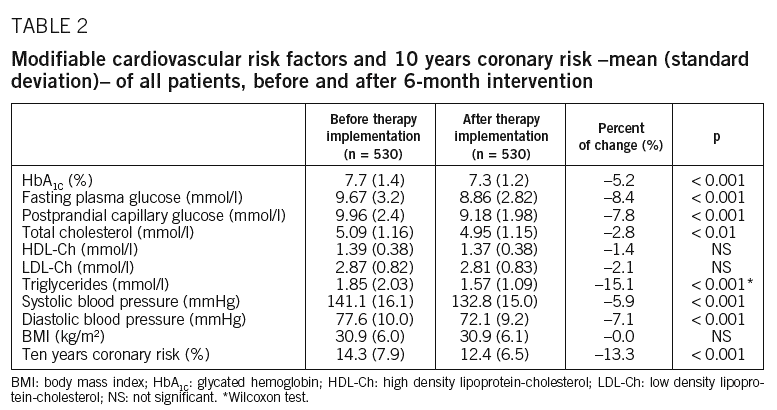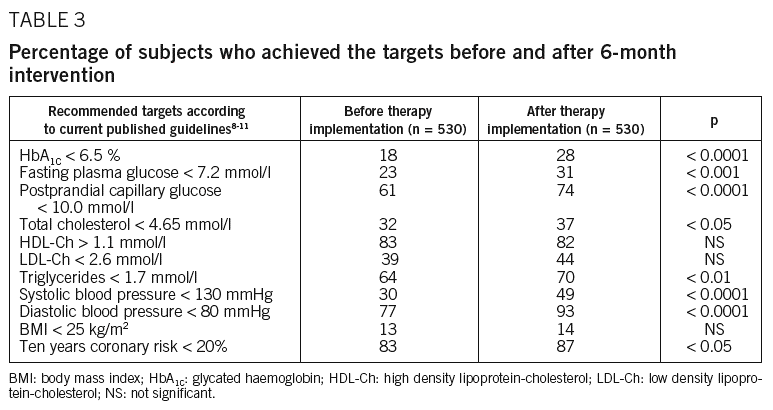Subjects with type 2 diabetes mellitus (T2DM) have a risk of myocardial infarction equivalent to that of non-diabetic persons who have a previous myocardial infarction1, due to the association between T2DM with cardiovascular risk factors (CRFs), such as hyperglycemia, hypertriglyceridemia, low high-density lipoprotein-cholesterol (HDL-Ch), high low-density lipoprotein-cholesterol (LDL-Ch) levels, and hypertension. However, recently in the Tayside Study2, a cross-sectional and cohort study using routine collected datasets, patients with T2DM were at lower risk of cardiovascular outcomes than patients with established coronary heart disease. There is a substantial amount of evidence in the literature demonstrating that the modification of a single risk factor in patients with T2DM is associated with benefits in terms of both macrovascular and microvascular complications3-5. In randomized trials as the Steno-2 Study6, a target-driven, long-term, intensified intervention aimed at multiple risk factors in patients with T2DM and microalbuminuria, the risk of cardiovascular and microvascular events was reduced about 50%. On the other hand, a poor control of the majority of CRFs in a T2DM population has been reported in clinical practice7. However, it has not been proved whether the reduction of coronary risk (CR) associated with an intensive control of CRFs observed in randomized studies is relevant in routine clinical practice.
The objective of this study was to assess in our clinic the effect of a strict control of modifiable CRFs on CR in treated T2DM patients with one or more modifiable CRFs above recommended goals.
Patients and method
Study design
A longitudinal, open and observational study was designed to evaluate, in practical clinical conditions, the effect of a strict control of CRFs on CR in a sample of treated T2DM patients with one or more modifiable CRFs above recommended goals, attended at our outpatient clinic of Endocrinology.
Patients
This study was conducted at out-patient Endocrinology clinic of Montes de Barbanza public health center, a specialized secondary referral center, that provides services to the 31 urban district of Madrid (Pueblo de Vallecas), in Spain (catchment population: 79,034 people). In 530 consecutive patients with T2DM and one or more modifiable CRFs above recommended goals, glycated hemoglobin (HbA1C), fasting plasma glucose (FPG), postprandial capillary glucose (PCG), total cholesterol, HDL-Ch, triglycerides, systolic blood pressure (SBP) and diastolic blood pressure (DBP) were measured; body mass index (BMI) and LDL-Ch were calculated; and 10 years CR were predicted using risk factor categories tables8, before and after 6 months of pharmacologic therapy implementation to get the goals recommended by current published guidelines9-11. The percentage of patients who reached the targets, and the use of insulin, angiotensin converting enzyme inhibitors (ACEIs) and/or angiotensin receptor blockers (ARBs), statins, antiplatelet drugs and beta-blockers were compared before and after therapy implementation The study was conducted according to guidelines for good clinical practice, and was approved by our hospital ethical committee.
Glucose and lipid profiles
In addition to routine ingredients, FPG, HbA1C, total cholesterol, HDL-Ch, and triglycerides were measured in all of the subjects after an overnight fast. Only 369 of 530 patients were self-monitoring capillary glucose by home reflectance meters. The PCG was the mean of the last postbreakfast, postlunch and postdinner capillary determinations. FPG was measured by a glucose oxidase method. HbA1C was determined by high-performance liquid chromatography (reference range: 3.5% to 6.5%). Total cholesterol, HDL-Ch and triglycerides were estimated by enzymatic methods, and LDL-Ch was calculated using the equation of Friedewald. Dyslipemia was considered to be present if patients were on treatment or if lipid parameters were above the targets.
Blood pressure measurements
SBP and DBP were measured in all patients after 10 min rest, with use of a standard brachial cuff technique. Hypertension was considered present if patients were on treatment or if SBP and/or DBP were above the targets.
Anthropometric variables
Same observer performed all anthropometric measurements. The patients were weighed to the nearest 0.1 kg and measured for height to the nearest 0.1 cm. BMI was calculated as weight divided by square height (kg/m2).
Outcomes
To assess the degree of control of multiple modifia-ble CRFs in the population studied, the data of our patients were compared with current published guidelines8-11, before and after 6 months of pharmacolo- gic therapy implementation. We applied the following goals for our comparisons: HbA1C < 6.5%; FPG < 7.22 mmol/l; PCG < 10.0 mmol/l; total cholesterol < 4.65 mmol/l; HDL-Ch > 1.16 mmol/l; LDL-Ch < 2.6 mmol/l; triglycerides < 1.7 mmol/l; SBP < 130 mmHg; DBP < 80 mmHg, and 10 years CR < 20%.
Statistical analysis
Mean values were compared with a paired-samples t test. Because the distribution of the serum triglycerides was not normal, we compared their mean values with the Wilcoxon nonparametric test. The *2 test was used to compare categorical related samples (McNemar test). All statistical analyses were performed using the SPSS for Windows statistical program (version 13.0, Chicago, SPSS Inc., USA). A level of p < 0.05 was considered statistically significant.
Results
Characteristics of the study population
Baseline characteristics of the study population are presented in table 1. Our study sample consisted of 530 T2DM patients. The mean (standard deviation) age was 66.5 (11.4) years; 43% were male and 19% had previous events of coronary ischemic disease. Overall, 53% patients received insulin therapy alone or both insulin and oral hypoglycemic drugs, and the remaining 47% took oral hypoglycemic agents alone.
Effect of pharmacological intervention on cardiovascular risk factors and coronary risk
Separate analyses for men and women showed no significant differences between genders. Therefore, results were reported for the combined male and female population.
The effect of therapy implementation on modifiable CRFs and CR are shown in table 2. There was a significant decrease in mean HbA1C, FPG, PCG, total cholesterol, triglycerides, SBP, DBP, and 10 years CR after intervention (p < 0.001, < 0.001, < 0.001, < 0.01, < 0.001, < 0.001, < 0.001, < 0.001, respectively), while changes for HDL-Ch, LDL-Ch and BMI were no significant.
The percentage of subjects that achieved the targets before and after intervention is shown in table 3. The percentage of patients who reached the current published recommendations increased significantly after intervention for HbA1C, FPG, PCG, total cholesterol, triglycerides, SBP, DPP, and 10 years CR (p < 0.0001, < 0.001, < 0.0001, < 0.05, < 0.01, < 0.0001, < 0.0001, < 0.05, respectively). However, there were no significant changes for HDL-Ch, LDL-Ch and BMI.
Use of drug therapies
The medication profiles of all patients revealed that therapy increased significantly after intervention for insulin (53% vs 58%; p < 0.0001), ACEIs and/or ARBs (69% vs 71%; p < 0.05), statins (77% vs 82%; p < 0.0001) and antiplatelet drugs (25% vs 34%; p < 0.0001), but beta-blockers remained unchanged (table 4).
Discussion
These data indicate that a strict control of modifiable CRFs in treated T2DM patients has a beneficial effect over predicted CR in these patients. Our results, carry out in practical clinical conditions, are in line with randomized trials such the Steno-2 study report in T2DM patients with microalbuminuria6.
Numerous studies have observed that an intensive control of a single risk factor such as hypertension3, dyslipemia4 and blood glucose5 in patients with T2DM is associated with reductions in macrovascular and microvascular complications, but in our study the 13,3% reduction in CR is higher than the reduction in the risk of cardiovascular events observed in these studies.
The UKPDS study found that a decrease of 0.9% in HbA1C was associated with a 3% reduction in the risk of myocardial infarction5. In the present study, we found also a significantly reduction in HbA1C, FPG and PCG, and more percentage of subjects reached the glucose targets after pharmacological implementation. Several studies have recently reported that postprandial glucose concentrations at 1; 2, and 5 h after a meal were better predictors of the HbA1C than prebreakfast or prelunch values in patients with well-controlled type 2 diabetes12,13. Although a strong correlation between elevated postprandial glucose levels and the risk of developing cardiovascular disease has been reported14, there is a need for larger clinical trials to demonstrate this relation.
A strict treatment of dyslipemia with statins for 5.4 years for secondary cardiovascular prevention has been shown to reduce the absolute risk of cardiovascular events about 19% in diabetic patients with elevated serum total cholesterol15. The administration of gemfibrozil, a fibrate that decreases triglycerides concentrations, for 5.1 years to diabetic patients with prior coronary artery disease, was associated with a 24% reduction in cardiovascular events in these subjects16. Moreover, the Heart Protection Study provided evidence that cholesterol-lower therapy is beneficial for people with diabetes even if they do not already have manifested coronary ischemic disease or high cholesterol concentrations4. In line of the strong evidence in favour of aggressive treatment of lipids in diabetic population to reduce CR, in our study we observed a significantly reduction of total cholesterol and triglycerides levels, and more patients reached the total cholesterol and triglycerides targets. However, plasma levels of HDL-Ch and LDL-Ch were not changed significantly after therapy implementation and less patients achieved the HDL-Ch targets. It is well known that 60% to 70% of coronary events still occur, despite interventions aimed at LDL-Ch17. The lack of a treatment effect on HDL-Ch and LDL-Ch may be due to the fact that the patients of the present study were treated diabetics and showed baseline levels of HDL-Ch relatively high (1.39 mmol/l), and levels of LDL-Ch relatively low (2.87 mmol/l) for T2DM patients. On the other hand, the use of statins in a clinical practice led to observed reductions in LDL-Ch level that were significantly less than those projected by package insert guidelines18. Moreover, studies show that in clinical practice the effect of statins increasing HDL-Ch is slight19,20.
In the current study the reduction of 8.3 and 5.5 mmHg in SBP and DBP, respectively, are in line with randomized trials such the Steno-2 study6 report in T2DM patients with microalbuminuria, in which decreased SBP and DBP by 10 and 5 mmHg, respectively, after 8 years significantly reduced both the absolute risk of stroke and the combined end point of diabetes-related death, death from vascular causes, and death from renal causes by 5%. Similar reductions in the CR were observed in subgroup analyses of patients with T2DM in the HOT Study21, which treated elevations in DBP for an average of 3.7 years. On the other hand, an isolated systolic hypertension is a major hazard for coronary artery disease in diabetic patients22. A decrease in SBP of 10 mmHg in patients with T2DM, in line with our results (8,3 mmHg), is associated with a decrease in myocardial infarction of 11%23. Moreover, the treatment of systolic hypertension for 4.7 years24 and for 2 years25 reduced the absolute risk of cardiovascular events by 8%24 and death from cardiovascular causes by 5%25.
The use of statins, insulin, ACEIs, ARBs, antiplatelet drugs and beta-blockers reduce cardiovascular death and the incidence of cardiovascular events in diabetic patients4,26-30. In line with these data, in our present report the percentage of patients treated with insulin, statins, ACEIs and/or ARBs increased significantly after intervention.
In summary, this short-term study showed that, in clinical practice, the reductions in CRFs levels and 10 years CR observed after 6 months of pharmacological implementation were in line with the reductions seen in randomized trials after 4 and 8 years of intervention. Because one third of patients with T2DM are at increased risk for macrovascular and microvascular complications, our findings have considerable implications in clinical practice for the treatment of T2DM patients with CRFs and an increased CR. Although long-term studies are in progress, an approach involving a focused multifactorial intervention with pharmacologic implementation, outpatient education programs and strict targets to get the goals of CRFs recommended by the accepted guidelines, should be offered to T2DM patients with CRFs and an increased CR, to reduce macrovascular complications.














